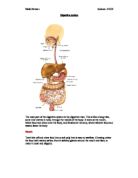Data collection
Data Analysis
- Relate your observations about the various parts of the rat digestive tract to the functions that these parts perform.
Discussion
- Do you think the rat is a herbivore, omnivore or carnivore?
Justify your answer in light of your observations.
- A tiger is a predator that hunts and kills other animals for food.
Suggest ways in which the digestive tract of a tiger would differ from that of the rat.
Give reasons for these differences.
- Suggest ways in which the digestive tracts of the tiger and the rat would be similar.
Give reasons for your suggestions.
Answers
1. The teeth of the rat could be divided in two groups. The first group includes the four teeth that appeared when his mouth was opened. They are known as incisors. The incisors have a sharp format that turns possible to the rat to catch and kill animals. The grinding teeth that are used to chew plant and seeds and eventually meat, form the second group.
The oesophagus is long (about 4.5 cm in length) and thin and its function is to connect the mouth to the stomach, transporting all the food.
The liver is quite big (approximately 5.5 cm in length) and has a bag format. This possibilities liver to perform many different functions such as regulate blood glucose levels, store glycogen, iron and vitamins production. It is also responsible for breaking down amino acids to release ammonia.
The stomach is important as a food storage organ. While food is being stored in the stomach, it is changed into chyme, a soft semi-fluid mixture, by a combination of mechanical churning and chemical breakdown. The stomach has a bag format which helps storage food.
The small intestine is long, with a large surface area (millions of tiny folds in the inside wall), and is thus well suited for absorption.
The large intestine has thinner and more easily stretched walls, providing a large capacity of storage.
2. The rat is an omnivore because it was possible to find characteristics that define both carnivores and herbivores. Thus, we can conclude that the rat, having characteristics of carnivores and herbivores, is an omnivore. Rats have extremely powerful teeth to probably catch and kill other animals. This is clearly a carnivore characteristic. Otherwise, the rats have an active caecum, a pretty longer small intestine and approximately twenty flat teeth (to chew plants and seeds), all characteristics of a herbivore.
3. The tiger, as it saying above, is a predator that hunts and kills other animals for food. In other words, the tiger is a carnivore, consumes other animals. In other way, the rat consumes also plants and seeds. Considering these facts, we can say that the digestive systems are shorter and simpler in carnivores than in omnivores. Tiger’s digestion is quicker and more efficient because animal foods have a much higher proportion of extractable energy per gram than plant foods. Plant material must be repeatedly ground by the teeth to expose as much surface area as possible for enzyme action and to release the contents from broken cells. As a food, plants provide less energy than meat and it takes a long time to extract energy. A tiger than, spend less time eating and can not eat for days between meals.
Another difference between the two digestive tracts is that the tiger should have bigger and stronger teeth in the front row to kill other animals, the canines, not present in the rats. The rats have more flat teeth to chew plants and seeds. The caecum of a carnivore, such as a tiger, is inactive, while the caecum of a rat is working.
4. All digestive systems have many similarities because all of them have the same purpose, the purpose of digestion – to rapidly break down organic food into molecules small enough to be able to pass through cell membranes and into cells. Both digestive tracts (rat’s and tiger’s) have two processes of digestion: the mechanical and chemical breakdown. The first one consists on the physical breakdown of food into smaller pieces, to increase the surface area available for enzyme action. The chemical digestion involves enzymes that break complex molecules into simpler molecules. Unlike chemical digestion, the mechanical breakdown not chemically changes the molecules.
Conclusion
The digestive tract of the rat was successful located, identified and described. With the observations, we could analyze why the rat is an omnivore, what parts of its digestive system are similar and what parts are different from a carnivore digestive tract and what are their functions in the digestion.
We could discover also the difference between the types of feeding behaviour and why they are so essential to understand.
Bibliography
-
Evans, Barbara, Ladiges, Pauline, McKenzie, John & Sanders, Yvonne1999, Biology One, Heinemann, Melbourne.







